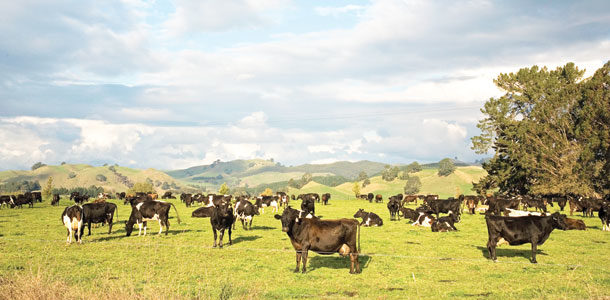No matter where you are, there are some things on a dairy farm that stay the same: the daily routine, caring for calves, farm chores and understanding milk payouts. It is the difference in location, policy and farm culture, leading to small changes in how a farm is run, which create different systems around the world. In New Zealand, farm life is very much influenced by milk pricing, and many production decisions are based on anticipated pay for the future year.
As many of you already know, New Zealand farmers receive their milk check based on kilograms of milk solids produced. This means that instead of aiming for volume, most farmers are trying to produce high-component milk.
The farm gate milk price for Fonterra producers was $8.40 NZD ($7.32 USD) per kilogram of milk solids for the 2013 milking season, as of May 29, 2014. Fonterra shareholders will receive an extra $0.10 per kilogram as their dividend payment.
This is one of the highest payout years for dairy producers, particularly when compared to the 2012 season payout of $5.80 or $6.12 for shareholders. Farmers are paid monthly for their production and receive an end-of-year payment that includes any dividends or increases in payout. Like their U.S. counterparts, they also receive payment premiums for milk quality.
The other dairy companies in New Zealand offer very competitive pricing to Fonterra, with payouts being similar. Some of the newer, privately held companies are offering better prices for the 2013 season and do not require farmers to purchase shares, leading to some shifting alliances within the industry.
Also, some of the other cooperatives offer lower share prices, allowing farmers to buy in without as much capital. Westland Co-op, for example, keeps it share price at $1.50 NZD, while Fonterra share prices fluctuate on the market and are currently selling around $7 NZD per share.
With the average New Zealand dairy producing 139,000 kilograms of milk solids, an investment to become fully “shared-up” in Fonterra shares would cost around $973,000 NZD, while for Westland it would be $208,000 NZD.
One potential reason for the high cost of Fonterra shares is that the company allows trading and holding of “dry shares” or those that are not associated with milk production. Farmers can buy and sell shares amongst themselves, a program known as Trading Among Farmers, without Fonterra acting as a middleman.
Non-farmer investors can also buy shares in the Fonterra Shareholders Funds, which are traded openly on the NZX market. Thus, shares in the company are being treated more like an investment and less like a right to supply the company, leaving some farmers feeling like they are being priced out of the market to supply Fonterra.
One farmer I spoke with has friends in an area where a new Chinese-owned company, Oceania, is seeking out suppliers for their factory, set to start operating later this year.
His friends, who operate a larger-than-average farm, will be selling their Fonterra shares for around $3 million NZD, and because Oceania is not a cooperative, they can use that income to pay off farm debt.
Because so many dairy farmers are highly leveraged and operate under heavy debt loads, the allure to sell out of the cooperative is strong. Further, in the past when a Fonterra-supplying farm was sold, the shares and the land were sold together as a package.
The emergence of other processing companies and the high price of Fonterra shares has encouraged the “unbundling,” as it is known in New Zealand, of the farm and the shares.
Some people in the industry think the disassociation of land and shares is leading to the rising numbers of new dairies working with a company other than Fonterra and avoiding additional capital outlay in buying shares.
The other primary dairy companies in New Zealand include Synlait, majority-owned by a Chinese company; Open County, majority-owned by a New Zealand company; Miraka, owned by Maori trusts and incorporations; Gardians, privately owned New Zealand company but just purchased by Danone; Westland, a cooperative based on the West Coast of the South Island; and Tatua, a small North Island cooperative with 112 shareholders located within a small radius of the processing facility.
Regarding production, a major difference I noticed in New Zealand is that farmers here are quick to adjust their herd numbers and management practices based on milk payouts, environmental conditions and feed supplies.
The predicted payout for next year is lower, so some farmers have been talking about milking more cows to make up the difference while others will be changing management strategies.
This year’s higher pay has also encouraged some farmers to add in supplemental feed to increase their production even more to take advantage of the income gains.
Farmers have included palm kernel expeller, grain or additional fodder crops such as kale or beets to their grass-based routine. When payouts decrease, many farmers will drop the additional inputs to save on costs even if it is during the milking season.
Because most dairies are seasonal, and those that milk year-round tend to only have two calving periods (spring and fall), farmers can adjust their cow numbers as the season progresses. If there is inclement weather that prohibits pasture growth, feed prices rise too much or milk payouts drop, many farmers will separate their herds into “lights” and “heavies.”
The light cows, those that need to put on more body condition, will be switched to 1X milking or dried off if it is toward the end of the season. By doing this, the farmer has immediate control over costs and is able to manage feed resources according to conditions.
Another adjustment farmers make is the breed of cow used. While most have a personal preference for breed, this is usually tempered by location and feed resources. Farmers I met with tended to milk a “kiwi-cross,” a Holstein-Jersey cross that is smaller in stature, has better feed conversion and is hardier than their purebred counterparts.
Since the cows spend their lives on pasture, the cows need to be suitable for living a life outdoors while not damaging the ground during the wetter months. Holsteins seem to be more popular in areas where the soil is rocky or sandy; smaller kiwi-cross cows seem to be more plentiful in areas that receive a greater amount of rain or have clay soils.
Many farmers like to mix up their breeding and add in Guernsey, Ayrshire or Brown Swiss genetics if they think it will add depth to their herd. PD
Laura Ginsburg is currently in New Zealand on a Fulbright studying dairy policy and farmer decision-making. She wrote her master’s thesis on Montana’s supply management system.
Photo by Thinkstock.





